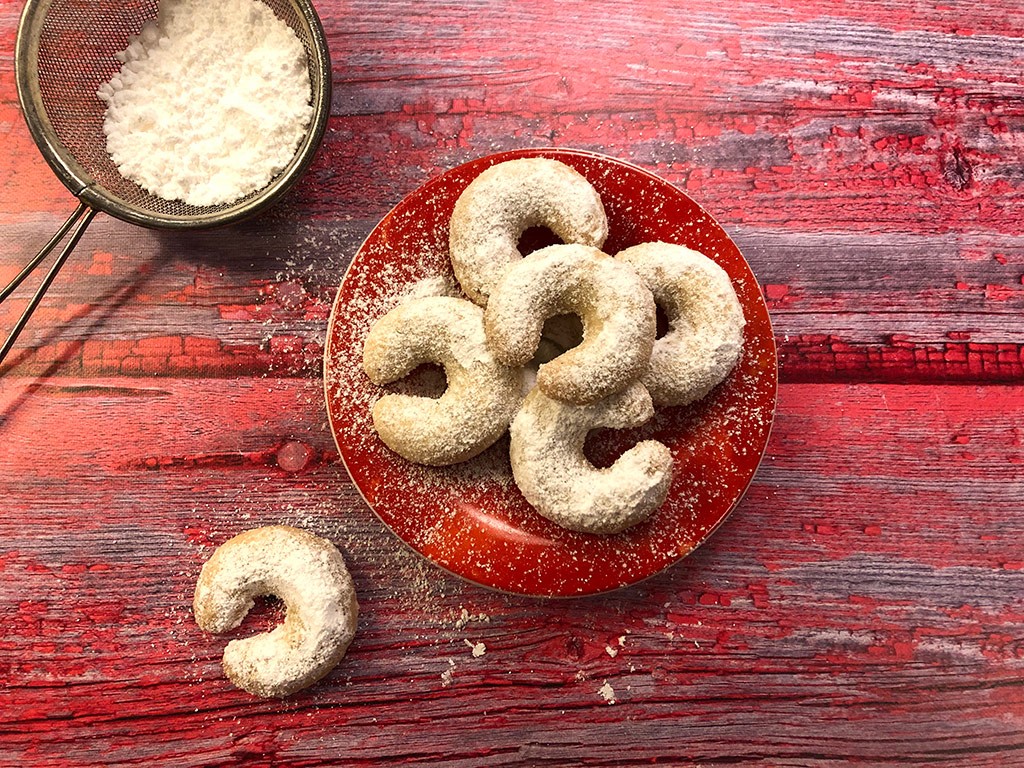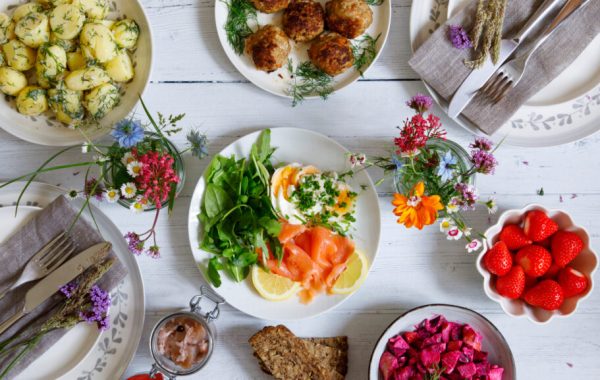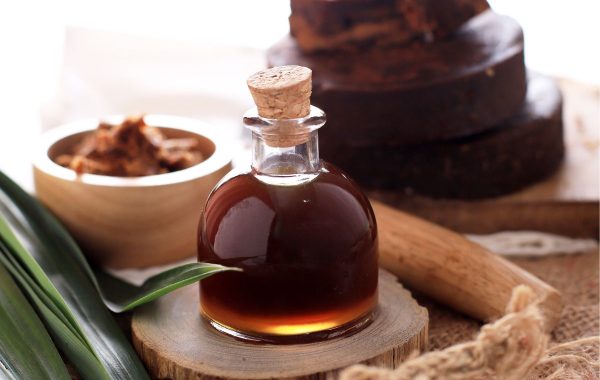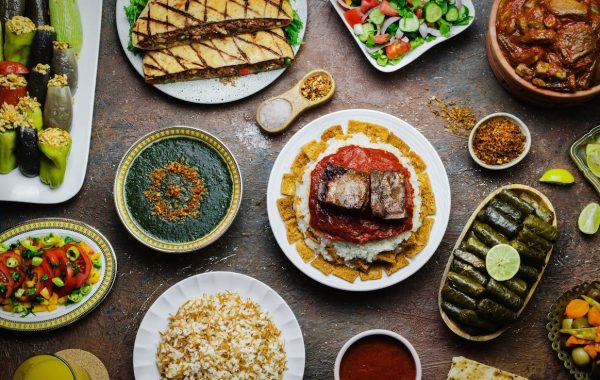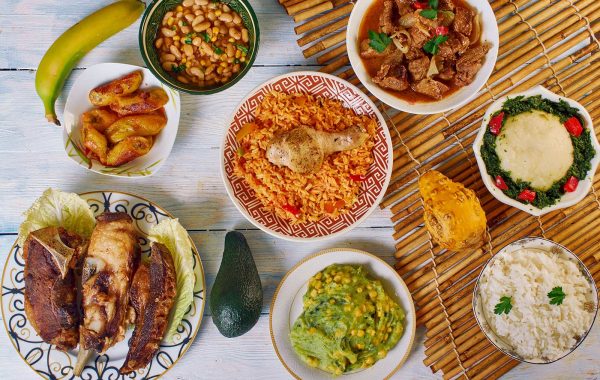Vanillekipferl, crescent-shaped shortbread cookies dusted with vanilla sugar, are had by the dozen during Christmas in Austria. Photo by: Nagy Julia/shutterstock
Vanilla-scented biscuits from Serbia, almond-kissed ones from Italy, and fruity tartlet from Malaysia—bake these traditional biscuits to beat the quarantine blues.
Home bakers are taking comfort in their pillowy loaves of bread and flaky pastries, recreating memories of that neighbourhood café or the faraway delis that nourished them on their travels. It’s going to be a while until we visit them again, but with these easy recipes of biscuits and tarts, you can bring those cafés and patisseries to your kitchen. The next time you fire up the oven, try a buttery shortbread from Spain, spicy biscuits from Germany, or the dulce de leche cookie sandwich from South America. Let the journeys begin.
Vanillekipferl, Austria
These crescent-shaped shortbread cookies dusted with vanilla sugar are had by the dozen during Christmas in Austria. Although some recipes call for eggs, skip them if you’re going truly local. Whisk ground walnuts (or ground almonds or hazelnuts), flour, butter, vanilla sugar, and salt to make the dough. Wrap it in a cling film and refrigerate for an hour. Roll the dough into little cylinders and cut them to resemble crescent moons before placing them on a baking sheet. Once out of the oven, coat each cookie with a generous layer of vanilla sugar.

Many have figuratively donned chef’s whites during the pandemic, looking to home baking (left) as an outlet for comfort and creativity; Traditional cookies are enjoyed at Christmas markets (right) across Europe. Photos by: MintImages/Shutterstock (woman), Marbury Shutterstock (cookies)
Kueh Tart, Singapore and Malaysia
Pineapple tarts with a Southeast Asian spin? That’s keuh tart for you, a shortcrust pineapple jam treat. The popular snack is found in most Malay Muslim households during the Hari Raya celebrations, and during Chinese New Year festivities in Singapore. The bite-sized pastry is topped with pineapple jam—both of which can be easily made and stored at home. Whip eggs and condensed milk until smooth, and fold this mixture and butter into the flour. Wrap it in cling film and refrigerate. Roll out the dough and use a cookie cutter with an indentation at the centre (for the jam filling) to cut out tiny discs. Refrigerate again before setting it to bake. You know you’ve been transported to Southeast Asia when the tarts come out looking beige and beautiful.
Matcha Cookies, Japan

Earthy tones and bittersweet flavours dominate the Japanese matcha cookies. Photo by: /StockFood/ Dinodia Photo Library
Like everything else, the Japanese have innovated cookies too. Matcha’s strong, earthy tones and soothing, bittersweet taste makes it a versatile baking ingredient. For matcha cookies, all you need is the powder, butter, sugar, eggs, sea salt and flour. Add a dash of vanilla extract or white chocolate chips, if you like, but it’s best to not meddle with the original flavours.
Mbatata, Malawai
Sweet potato is not what comes to mind when you think of baking a biscuit. It is, however, the hero ingredient of the Malawian treat, mbatata. These cookies are often heart shaped to celebrate the Malawian people, whose friendly hospitality has earned the country the moniker, Warm Heart of Africa. Mbatata are soft and cakey, and get their delicate sweetness from raisins and sweet potatoes. Toss melted butter, flour, brown sugar, baking powder, mashed sweet potatoes and salt in a bowl, and mix well. Make it rain raisins. Roll and cut out heart-shaped dough, place it on parchment paper, and leave it in the oven to bake until it’s firm and slightly springy to touch. Relish your labour of love.
Vanilice, Serbia

In Serbia, Vanilice, meaning ‘little vanillas,’ are bite-sized walnut cookie sandwiches dunked in jam and vanilla-scented powdered sugar. Photo by: Vesna Markovic/shutterstock
Vanilice, meaning ‘little vanillas,’ are bite-sized walnut cookie sandwiches dunked in jam and vanilla-scented powdered sugar that are served on auspicious occasions in Serbia. This one’s a tad demanding and needs at least two days of prep—but the wait is worth it. The two main ingredients of this recipe—leaf lard and vanilla sugar—are not easy to get during lockdown, so substitute them with vegetable shortening and vanilla essence. In a large bowl, mix the shortening, butter and sugar until it’s creamy. Beat in the egg yolks, vanilla extract, lemon zest, ground walnuts and flour, one ingredient at a time. Divide the dough in two halves, wrap them separately in plastic, and refrigerate overnight. Roll out the dough (one half at a time) on a flour-dusted countertop and cut out the cookies using a round cookie cutter. Bake until just before they start to turn golden around the edges. Once completely cool, lather them on the inside with jam (traditionally apricot or rose hip, but any flavour works wonders in this recipe). Roll them each in powdered vanilla sugar and store away in an airtight container to allow the flavours to mingle, and for the cookies to soften. Reap your reward in a day or two.
Alfajores, South America

Alfajores, cornstarch cookies sandwiched with dulce de leche, sell like hot cakes in South America. Photo by: LARISA BLINOVA/ Shutterstock
This traditional confection—which is dulce de leche pressed between cookies—is enjoyed throughout South America. It is especially beloved in Argentina and Uruguay since the mid-19th century, and some variations pop up across North America, the Caribbean and Spain too. Combine flour, cornflour, baking powder and a pinch of salt in a bowl. Whisk butter, sugar and lemon zest until the mixture pales. Crack open and filter only the egg yolks, followed by the cognac and vanilla extract. Wrap the dough in cling film and refrigerate. Roll out the dough, make coin-sized balls of it and bake. Lather dulce de leche between two cookies, roll the sides of this sandwich in desiccated coconut, and take a bite to reach cookie heaven.
Amaretti, Italy
These almond-flavoured macaroons are household favourites in Italy and the recipe varies with region. They are airy-crispy on the outside and slightly chewy within. Assemble egg whites, caster sugar and ground almonds in a bowl and drizzle amaretto liquor to make a smooth paste. Grease the baking tray with butter, top it with heaps of the mixture before putting it inside the oven. Bake until golden brown and sprinkle it with icing sugar. Bite into their goodness in between sips of espresso.
Nankhatai, India

Dollops of ghee go in the making of nankhatai, an Indian household favourite. Photo by: D Shah/ Dinodia Photo / Dinodia Photo – LBRF/Dinodia Photo Library
Nankhatai is no stranger to Indian households. Sieve flour, baking powder, baking soda, sugar, semolina and cardamom seeds in a bowl. Don’t you skimp on the fat here—pour dollops of ghee into the mixture without kneading the dough. Mould them into tiny balls, flatten them in your palms, and then place them on parchment paper. Make criss-cross patterns on top using a fork or a toothpick, or simply sprinkle a topping of your choice (you can’t go wrong with chironji) before setting it to bake. Bite into these crumbly nankhatais with masala chai, and store some for another day.
Naan Berenji, Iran

Naan berenji, Persian rice and rose water flavoured cookie, are relished during Nowruz. Photo by: Velveteye/ Shutterstock
These Persian rice cookies are relished during several auspicious occasions including Nowruz, and do not require you to break a sweat. Beat butter and sugar, and add eggs and rose water to the mix. Fold in flour and cardamom, and refrigerate the batter overnight. Roll the dough into palm-sized balls and flatten into mini discs. Using the edge of a spoon, carve indentations on top and throw in a pinch of poppy seeds or even pistachios. Pop them all in the oven until the gluten-free cookies turn light gold.
Polvorón, Spain and the Philippines
This shortbread is popular in Spain and its former colonies in Latin America, and the Philippines. In Spanish, polvorón means powder or dust, which explains the soft, crumbly texture of the confection made with flour, milk, sugar, fat, and nuts (almonds galore). If you’re looking for a Filipino twist, mix it up with powdered milk, toasted flour, sugar, and butter or margarine, along with other ingredients such as ube (purple yam), kasuy (cashew nut), pinipig (crispy rice) or malunggay leaves. Divide the mixture into small portions using tin molds and freeze until firm. Wrap individually in colourful cellophane or Japanese paper to maintain freshness. It’s like a party on a platter!
Mango Melting Moments, Australia

The iced-and-spiced pfeffernüsse are popular Christmas treats in Germany. Photo by: Hjochen / Shutterstock
‘Tis mango season and no list is complete without an ode to the golden fruit. This recipe is known to have been published in an old edition of The Australian Women’s Weekly magazine. Sift flour, sugar and cornstarch in one large bowl, and mix butter, vanilla and lemon zest in another. Combine the two until you have a perfectly smooth dough. Make walnut-sized balls and leave them to bake in the oven until they’re pale and delicate. Whip up some mango buttercream using butter, sugar and mango purée in the meantime. Sandwich the cream between two cookies and savour the taste of childhood summers.
Pfeffernüsse, Germany
Some call it the German cousin of a molasses cookie, with an added spiciness of gingerbread and a hard-to-pronounce name. Pfeffernüsse—popular Christmas treats—translate to ‘pepper nuts’ in German. While the recipe does not contain nuts, it gains its unique flavour from a mix of warm, wintry spices sold in Germany under the name lebkuchengewürz. You can improvise with cinnamon, anise and pepper. Heat dark molasses, honey, and sugar in a saucepan until the sugar dissolves. Take the pan off the flame and stir in the salt and spices. Once cool, add milk, eggs, baking soda, and flour. Knead and make little balls from the dough; bake until the bottom of the cookies begin to brown. You’re not done just yet. The piquancy is best countered either with a hard icing coating or a powdered sugar-coating. Pair these iced-and-spiced cookies with a warm cuppa.
This feature also appeared in National Geographic Traveller India
For latest travel news and updates, food and drink journeys, restaurant features, and more, like us on Facebook or follow us on Instagram. Read more on Travel and Food Network
Trending on TFN
The 23 Best Places To Go In 2023
Explore Utah’s Mighty 5® and What Lies in Between
Five Epic U.S. National Parks To Visit This Year
Pooja Naik is a Mumbai-based journalist with a penchant for food, art, and adventure. Her affinity for travel has often led her to many cultural crossroads, whereby she savoured butter tea with the resident monks at Thiksey Monastery in Ladakh and guzzled an indigenous produce of green ant gin at a local’s behest in Australia. Her work has appeared in National Geographic Traveller Ind


